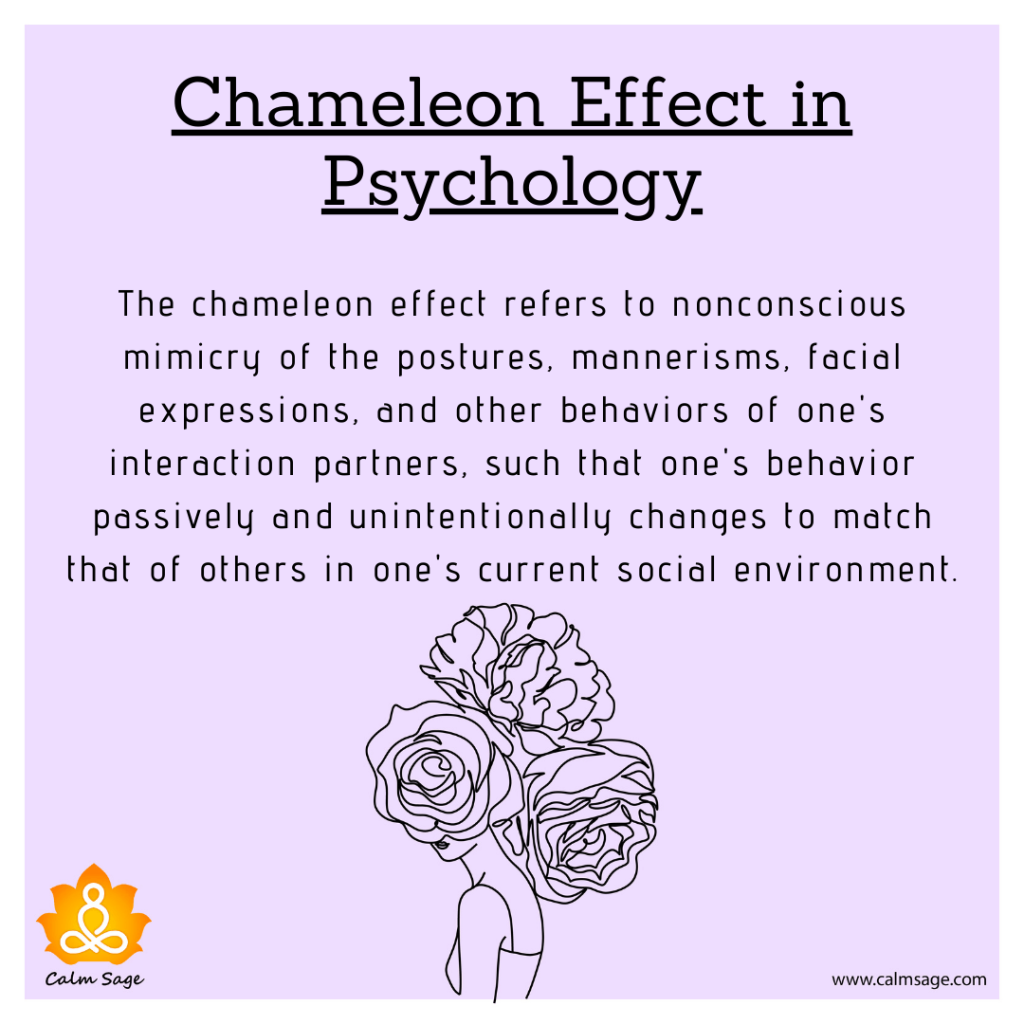Exploring the Chameleon Effect and The Psychology of Mimicry

Children imitate what they see, especially when it’s an action or behavior done by their parents. I’ve – on occasion – noticed how children (even adults) would mimic what they see. Now, I don’t know this about myself, but if you’ve ever noticed yourself mirroring the behavior or mannerisms of someone you were interacting with, then this could be the chameleon effect in action.
Maybe you’ve slowly adopted their gestures, tone of voice, or even facial expressions without being aware of it. This psychological effect is called the chameleon effect in psychology, and it helps us understand how interconnected we are as social beings.
In this article, we’re exploring more about this phenomenon with examples, how it impacts us – negatively and positively – and what you can do about this effect.
The Chameleon Effect in Psychology

When you subconsciously mimic the behaviors, expressions, and mannerisms of those you most interact with, that’s called the chameleon effect. I guess it’s pretty clear by the name about how this effect works. Just like a chameleon changes its colors to blend into its surroundings, we adapt our behavior to fit in with the people around us, especially those we most interact with.
This automatic blending or mirroring can occur in different social contexts – from casual conversations to formal meetings in a professional setting.
The chameleon effect is very effectively rooted in the innate drive for social interaction and belonging. As social beings, we are wired to seek acceptance and belonging with others. Mimicking the behaviors of those around us can help us boost rapport, signaling that we are a part of the same social circle.
Here are some examples of the chameleon effect to understand it better;
- When you’re having a conversation with a friend who is leaning towards you with their arms crossed, then you might subconsciously find yourself adopting a similar posture.
- When talking to somebody with an accent or speech pattern, you might subconsciously mirror the tone of voice, accent, or speech to create a sense of familiarity during the conversation.
- When you’re in a room full of laughing people, then you’re most likely to start laughing too, even if you don’t know what you’re laughing about. This contagious action is one of the classic examples of the chameleon effect in action.
The Impact of The Chameleon Effect
Now, in the past, you must’ve heard about how mimicry is something negative, but in this case, mimicry can have positive effects as well as negative ones. The chameleon effect is something that happens subconsciously, so it is perfectly natural and normal to mimic. I mean, let’s face it; when you live with someone for a long time, you’re bound to pick up some of their mannerisms, right?
Mimicking others’ actions and behaviors has been said to strengthen social bonds and improve communication by creating a sense of understanding between the people involved in the interaction. Moreover, when you see someone mimic your actions, it can make you favor the person more, leading to an increased likability and trust.
While the chameleon effect is a powerful tool for social interaction and bonding, it can have some negative consequences as well.
One of them could be the risk of losing your authentic self just to gain social acceptance. When you constantly mirror others, it can lead to a sense of disconnection from your own self, identity, and values. Now, mimicry is often seen as a non-verbal form of communication, so it might not always be interpreted as it’s meant to be.
Moreover, constantly mimicking others’ behaviors and gestures can create a sense of comparison, leading to feelings of inadequacy and inferiority. It can also trigger self-doubt and self-criticism.
How Does The Chameleon Effect Work?
This phenomenon works on a subconscious level, driven by mechanisms in the brain that are associated with empathy, social cognition, and mirror neurons. These mirror neurons are cells that are activated when we perform an action and when we observe someone performing the same action, leading to automatic imitation.
Now, there are two ways in which we can mimic others;
- Mirror Mimicry: When you mimic someone mirror wise, you do the opposite of what the other person is doing. For example, if they are moving their right hand while talking or gesturing, you would move your left while talking or gesturing.
- Anatomical Mimicry: When you make the same movements as someone else, you engage in anatomical mimicry. For example, if they are moving their left hand while talking, then you’ll also move your left hand.
When we engage in mimicry, our brains run a “simulation” of the other person’s behavior. This allows us to get a better understanding of their perspective and improves social connection by creating a sense of mutual understanding.
How to Mimic Positively?
The chameleon effect is a natural, if subconscious, response, so there’s not much you can practice about. But it is important to be aware of its pros and cons. Knowing about the effect can help you make the most of it and elevate your social connections. Here are some tips to help you adapt to the chameleon effect positively;
- Be Genuine: While mimicry is a powerful tool for building social connections, it’s important to remain authentic. Do not overdo it or mimic actions in ways that feel forced, as it can come across as insincere.
- Pay Attention: Be mindful of the cues from the one you’re interacting with. Look at their body language, tone of voice, and expressions. Adjust your behavior accordingly to connect with them without being overly obvious.
- Try Active Listening: Mimicry only works effectively when it is done with active listening. Only when you’re focusing on what others are saying and how they are saying it, can you naturally sync up your responses and connect with them.
Wrapping Up…
The chameleon effect might be a good source to offer insights into our complex social behavior. When you understand how you subconsciously mimic others, you can use this phenomenon to strengthen your social relationships, better your communication skills, and boost empathy.
So, the next time you find yourself mimicking someone’s actions, behaviors, tone of voice, or facial expressions, remember that it might not be a coincidence – it’s the chameleon effect in action!
That’s all!
Did this article help you understand what is the chameleon effect and how it works to foster social connection? Let me know what you think about this psychological phenomenon in the comments below.
Take Care!




















